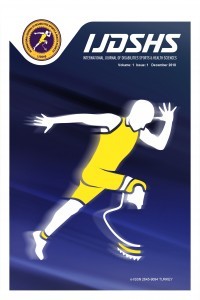Return to Job of A Construction Worker by Comprehensive Functional and Vocational Rehabilitation
Return to Job of A Construction Worker by Comprehensive Functional and Vocational Rehabilitation
Overhead activities, Rotator cuff tear, muscular imbalance Gleno -humeral force couple, joint stiffness,
___
- Bang, M.D., Deyle, G.D. (2000). Comparison of supervised exercise with and without manual physical therapy for patients with shoulder impingement syndrome. J Orthop Sports Phys Ther;30:126-137.
- Conroy, D.E., Hayes, K.W. (1998). The effect of joint mobilization as a component of comprehensive treatment for primary shoulder impingement syndrome. J Orthop Sports Phys Ther.;28:3-14.
- Davies GJ, Gould JA, Larson RL. Functional examination of the shoulder girdle. Phys Sportsmed. 1981;9:82104.
- Determe D, Rongieres M, Kany J, et al. Anatomic study of the tendinous rotator cuff of the shoulder. Surg Radiol Anat. 1996;18:195-200.
- Dvir, Z. (1997). Grade 4 in manual muscle testing: the problem with submaximal strength assessment. Clin Rehabil;11:36-41.
- Flatow, E.L, Cuomo, F., Maday, M.G., Miller S.R., McIlveen, S.J., Bigliani, L.U. (1991). Open reduction and internal fixation of two part fractures of the greater tuberosity of the proximal part of the humerus. J Bone Joint Surg (Am); 73:1213–1218.
- Green, A., Izzi, J. (2003). Isolated fractures of the greater tuberosity of the proximal humerus. J Shoulder Elbow Surg;12:641–649.
- Goti, T.S., Shinde, S.B. (2020). (Effect of scapular position-motion maintenance exercise programme during post traumatic shoulder immobilization. Indian Journal of Public Health Research & Development; Jan 1;11(1):702-8.
- Kim, S., Ha, K. (2000). Arthroscopic treatment of symptomatic shoulders with minimally displaced greater tuberosity fractures. Arthroscopy; 16:695–700.
- Kei Cheng, A.S., Kim Hung, L. (2007). Randomized Controlled Trial of Workplace-based Rehabilitation for Work-related Rotator Cuff Disorder: J Occup Rehabil; 17:487–503.
- La Briola, J.H., Mohaghegh, H.A. (1975). Isolated avulsion fracture of the lesser tuberosity of the humerus. A case report and review of the literature. J Bone Joint Surg Am;57:1011.
- Jaju, C.S., Shinde, S. (2019). Prevalence of peripheral neuropathy in chronic musculoskeletal oedematous conditions. Int J Physiother; 6(6): 282-286.
- Neer, C.S. (1970). 2nd. Displaced proximal humeral fractures. Part I. Classification and evaluation. J Bone Joint Surg (Am); 52:1077–1089.
- Shah, P.S., Shinde, S.B. (2018). Effect of desensitization methods during the early mobilization phase in post-fracture conditions of upper extremity. Asian journal of pharmaceutical and clinical research; Jul 7:93-6.
- Zanetti, M., Weishaupt, D., Jost, B., Gerber, C., Hodler, J. (1999). MR imaging for traumatic tears of the rotator cuff: high prevalence of greater tuberosity fractures and subscapularis tendon tears. AJR Am J Roentgenol;172:463-467.
- Yayın Aralığı: Yılda 3 Sayı
- Başlangıç: 2018
- Yayıncı: Nevzat DEMİRCİ
Gizem Yağmur YALÇIN, Ayşe BESER, Murat KÜRTÜNCÜ
Seveka BALİ, Devi DAYAL, Amrit Pal Singh SOOD, Sougata PANDA, Priyanka GUPTA
Yeliz BÜYÜKTEPE, Emre ŞENOCAK, Aysel YILDIZ ÖZER
Effect of Pranayama Exercise on Breath-Holding Capacity of Soccer Players
Laishram Santosh SİNGH, Salam Opendra SİNGH, Oinam Puya DEVİ, Waribam James SİNGH, Sarungbam Sen SİNGH
Emre Serdar ATALAY, Güler ATALAY
Burnout, Anxiety and Coping Attitudes in Parents of Children with Autism Spectrum Disorder
Selma ERCAN DOĞU, Ayşe Gökçen GÜNDOĞMUŞ
Effect of Physical Activity Interventions in Autism Spectrum Disorder
Turgay ALTUNALAN, Deniz DEMİRCİ, Sinem GÜL, Ahsen ÖZTEL
Return to Job of A Construction Worker by Comprehensive Functional and Vocational Rehabilitation
